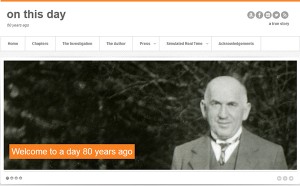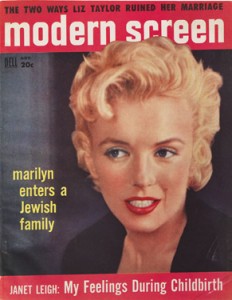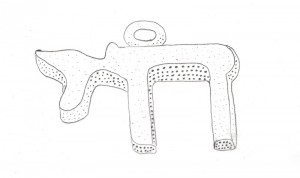Since January 30, 2013 you can find documents and photographs from our archival collections and those of the Leo Baeck Institute in our Online Showcase. We are, of course, not the only ones producing work online using historical sources as witnesses to the time of National Socialism. I have looked around and would like to use this post to make some recommendations:
 An impressive example is Torkel S. Wächter’s project. The Swedish writer arranged together 32 postcards when he decided to investigate the history of his German-Jewish family. His father Walter Wächter fled to Sweden in 1938 and began regularly receiving postcards from his parents, who had remained in Germany. Torkel S. Wächter created the internet project www.32postkarten.com out of them and in 2010/2011 – 70 years later, to the day, after the card was written – he published these last life testimonies of his grandparents, annotated and placed in historical context. Wächter is now again presenting his longstanding engagement with his family’s history as an online project: www.onthisday80yearsago.com. In a literary form – with the aid of letters, notes from journals, and official documents, he tells the story of his grandfather Gustav Wächter, a tax officer who lost his job due to his Jewish heritage and office scheming. Torkel S. Wächter published the chapters from January 30 to July 2, 2013 in “simulated real-time”, as he calls it, rather like a re-enactment of the events of 80 years ago. A serialized novel, a weblog, and memory itself merge together harmoniously here. → continue reading
An impressive example is Torkel S. Wächter’s project. The Swedish writer arranged together 32 postcards when he decided to investigate the history of his German-Jewish family. His father Walter Wächter fled to Sweden in 1938 and began regularly receiving postcards from his parents, who had remained in Germany. Torkel S. Wächter created the internet project www.32postkarten.com out of them and in 2010/2011 – 70 years later, to the day, after the card was written – he published these last life testimonies of his grandparents, annotated and placed in historical context. Wächter is now again presenting his longstanding engagement with his family’s history as an online project: www.onthisday80yearsago.com. In a literary form – with the aid of letters, notes from journals, and official documents, he tells the story of his grandfather Gustav Wächter, a tax officer who lost his job due to his Jewish heritage and office scheming. Torkel S. Wächter published the chapters from January 30 to July 2, 2013 in “simulated real-time”, as he calls it, rather like a re-enactment of the events of 80 years ago. A serialized novel, a weblog, and memory itself merge together harmoniously here. → continue reading
Why a particular subject captures the interest of the public at a given time is not always immediately apparent. Conversion, for instance, has become the topic of conferences, lectures and exhibits in German-speaking Europe without any notable change in its social significance nor religious practice.

Picture in the current special exhibition “The Whole Truth” accompanying the question: Jew or non-Jew? Marilyn Monroe on the cover of the Modern Screen Magazine, November 1956
© Jewish Museum Berlin, photo: Jens Ziehe
The number of converts to Judaism is invariably small. According to the data collected by the Zentralwohlfahrtsstelle der Juden in Deutschland, on average 64 conversions are carried out yearly in the various German-Jewish communities, and since the year 2000, the number has remained fairly stable. Nor has the size of the Jewish communities varied much. For over a decade, the number of members has stabilized at around 105.000. In relation to the size of the community, the total number of converts since 1990, 1.366, makes up under one percent of the Jewish community. The number of Jews leaving the communities is slightly higher, around one hundred a year, yet the number is not particularly meaningful, because it includes people who leave for all sorts of reasons, including financial. By all accounts, today’s Jewish converts are a minute and exotic minority.
Yet the topic is currently being discussed with much enthusiasm. → continue reading

The Involuntary Moose
Last summer, a snigger went viral in the Jewish online community when an eBay entrepreneur posted a pendant of a Navajo moose. Labeled a “Unique Vintage Navajo Moose 925 Sterling Silver Pendant, marking 0.8 grams,” the trinket for sale was in fact a Jewish amulet depicting the Hebrew word “chai” for “life/living.” The motif is popular in Jewish jewelry. It consists of the two letters chet and yod and is not commonly mistaken for an animal. But this particular example simplified the letters and joined them together, which made them appear, quite truly, like an antlered moose in Native American style. → continue reading
 An impressive example is Torkel S. Wächter’s project. The Swedish writer arranged together 32 postcards when he decided to investigate the history of his German-Jewish family. His father Walter Wächter fled to Sweden in 1938 and began regularly receiving postcards from his parents, who had remained in Germany. Torkel S. Wächter created the internet project www.32postkarten.com out of them and in 2010/2011 – 70 years later, to the day, after the card was written – he published these last life testimonies of his grandparents, annotated and placed in historical context. Wächter is now again presenting his longstanding engagement with his family’s history as an online project: www.onthisday80yearsago.com. In a literary form – with the aid of letters, notes from journals, and official documents, he tells the story of his grandfather Gustav Wächter, a tax officer who lost his job due to his Jewish heritage and office scheming. Torkel S. Wächter published the chapters from January 30 to July 2, 2013 in “simulated real-time”, as he calls it, rather like a re-enactment of the events of 80 years ago. A serialized novel, a weblog, and memory itself merge together harmoniously here. → continue reading
An impressive example is Torkel S. Wächter’s project. The Swedish writer arranged together 32 postcards when he decided to investigate the history of his German-Jewish family. His father Walter Wächter fled to Sweden in 1938 and began regularly receiving postcards from his parents, who had remained in Germany. Torkel S. Wächter created the internet project www.32postkarten.com out of them and in 2010/2011 – 70 years later, to the day, after the card was written – he published these last life testimonies of his grandparents, annotated and placed in historical context. Wächter is now again presenting his longstanding engagement with his family’s history as an online project: www.onthisday80yearsago.com. In a literary form – with the aid of letters, notes from journals, and official documents, he tells the story of his grandfather Gustav Wächter, a tax officer who lost his job due to his Jewish heritage and office scheming. Torkel S. Wächter published the chapters from January 30 to July 2, 2013 in “simulated real-time”, as he calls it, rather like a re-enactment of the events of 80 years ago. A serialized novel, a weblog, and memory itself merge together harmoniously here. → continue reading
